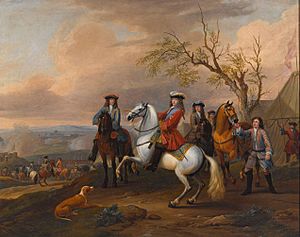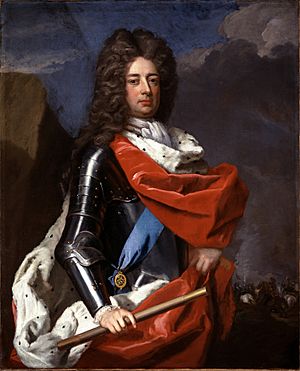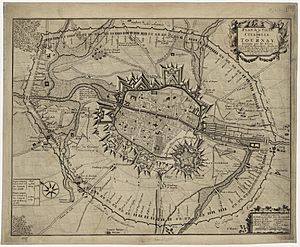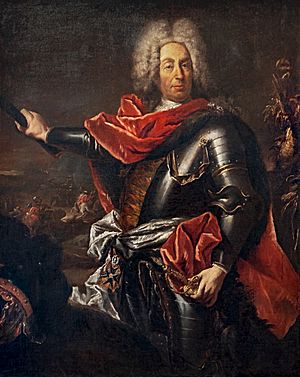Siege of Tournai (1709) facts for kids
Quick facts for kids Siege of Tournai |
|||||||
|---|---|---|---|---|---|---|---|
| Part of the War of the Spanish Succession | |||||||
 John Churchill, 1st Duke of Marlborough at the Siege of Tournai, 1709 by John Wootton |
|||||||
|
|||||||
| Belligerents | |||||||
| Commanders and leaders | |||||||
|
Marquis de Surville | ||||||
| Strength | |||||||
| ~50,000 | 7,700 | ||||||
| Casualties and losses | |||||||
| 5,300 | 1,729 dead 1,482 wounded |
||||||
The Siege of Tournai was a major battle during the War of the Spanish Succession in 1709. It involved a long attack on the city of Tournai, which was then part of France. An army called the Grand Alliance, led by the British Duke of Marlborough, successfully captured the city.
This siege was the first big fight of the 1709 war. Marlborough wanted to take Tournai quickly. This would let his army move into northern France. However, the French soldiers, led by the Marquis de Surville, defended the city much longer than expected. The battle used up a lot of the fighting season. Soldiers dug many tunnels and fought underground to break through the strong French forts. One historian called it "one of the hardest fought and least pleasant" battles in modern history.
Contents
Why Was Tournai Attacked?
At the start of 1709, the Grand Alliance wanted to keep pressure on Louis XIV, the King of France. They hoped to break through France's border forts and push into the country. However, the French army, led by Duke of Villars, had very strong defenses. A direct attack seemed too risky.
The Allied leaders decided they had to lay a siege instead. This meant surrounding a city and trying to capture it slowly. The French liked this idea because it would slow down the Allied army. Marlborough wanted to attack Ypres first. Ypres was closer to the coast and not as well defended as Tournai. Also, the Allied cannons were already near Ypres.
However, the Dutch part of the Alliance disagreed. They worried that attacking Ypres would leave their own lands open to French attacks. They also feared France might control the important Scheldt river. Attacking Tournai, on the other hand, would protect the cities of Ghent and Oudenaarde. It would also make the Allied supply routes safer. Even though Tournai was very strong, its defending army was quite small. So, the Allies agreed to make Tournai their main target for 1709.
Tournai's Strong Defenses
After an earlier battle in 1667, King Louis XIV ordered new, strong defenses for Tournai. These were built between 1667 and 1674. The main fort, called a citadel, was shaped like a pentagon. It had five strong points called bastions and thick walls connecting them. There was also a special emergency exit. The whole fort was surrounded by ditches and high earth walls called ramparts.
By 1709, Tournai was one of France's strongest fortresses. Lieutenant-General Louis-Charles de Hautefort de Surville was in charge of the city. His army had about 7,700 soldiers. This was not enough to fully defend all of Tournai's many forts. But the city had enough food and ammunition to last for four months.
The Siege Begins
June 28 to July 29: Attacking the City
On June 24, 1709, the Allied army pretended to attack Ypres. This tricked the French commander, Villars, into moving his army there. Then, the Allies quickly turned towards Tournai. By June 27, most of Marlborough's British and Dutch soldiers were outside the city. Prince Eugène's army arrived the next morning. On the night of June 28, Prince Eugène ordered bridges built over the swampy ground. This helped the Allied soldiers move between the two sides of the Scheldt river. Marlborough was in charge of the siege, while Eugène commanded the army protecting them.
On June 30, Allied soldiers began digging trenches around Tournai. The attacking force had 60 infantry groups and 70 cavalry groups. These soldiers were mainly from Britain, Austria, Prussia, and the Netherlands. There were also smaller groups from Denmark, Hesse, and Hanover. To stop the Allies, Surville blocked all the water locks. This made the river flood, making it very hard to cross. Still, by July 4–6, the Allies had surrounded the city with trenches. The French soldiers inside Tournai could no longer communicate with anyone outside.
Marlborough wanted to end the siege quickly. On the night of July 8, the Allies attacked three parts of the forts at the same time. The biggest attack was led by Lieutenant-General Lottum. The other attacks were led by Lieutenant-General Fagel and General Schulenburg. The attacking troops got very close to the outer defenses. But heavy rain stopped them from doing more work. On July 10, some of the Allied cannons finally reached Tournai. The French sent out 500 men to attack, but some of their soldiers ran away. The rest returned to the city.
By July 11, all the Allied cannons had arrived. They had 100 heavy guns and 60 mortars, brought by ship from Ghent. However, the heavy rain filled the trenches with water. The cannons could not be put in place. The shelling of Tournai finally began on July 13. Within a week, the Allies pushed the French out of their outer defenses near the citadel. On the night of July 20, the French tried to make a quick attack, called a sortie, near the Valenciennes Gate. The Allies pushed them back, but the French did manage to damage some of the Allied siege works. Another French attack the next night was also stopped.
On the night of July 26, Allied troops captured the water gates and important outer forts. On July 28, Eugène and Marlborough checked the siege works. A French attack with 200 men was stopped. Surville held a meeting with his officers. They decided to surrender the city and retreat to the citadel. About 4,000 to 5,000 French soldiers were left. On July 29, Surville surrendered the city of Tournai.
July 30 to September 3: The Fight for the Citadel
On July 30, Surville moved into the citadel with his remaining soldiers. He agreed that if he didn't get help by September 5, he would hand over the citadel to the Allies. The Allies entered the city and took control with 10 groups of soldiers. For a short time, both sides agreed to stop fighting. Surville sent a messenger to King Louis XIV to ask for orders. King Louis XIV refused to let the citadel surrender. He ordered the French soldiers to keep fighting. Instead, Louis offered a ceasefire in the Flanders area, but Marlborough rejected this.
After the city surrendered, Marlborough moved his camp to Orchies, about 19 kilometers southwest of Tournai. This allowed him to watch Villars' army better. He left his Prussian and Dutch officers in charge of the siege. On August 1, Prussian Lieutenant-General Lottum began the attack on the citadel. A British soldier described the citadel as "an incredibly strong place for mines."
On August 8, Lieutenant-General von Schulenburg started a second attack. However, the two commanders did not work well together. Many Allied soldiers were lost, even in the last days of the siege. Digging tunnels and fighting underground became a big part of the battle for the citadel. These fights happened in terrible conditions. On August 26, the French blew up a mine, killing over 400 Allied soldiers. On August 27, the French tried to attack from the citadel. But some of their own soldiers told the Allies about the plan, and German soldiers stopped the attack.
With food running low, Surville offered to surrender to Marlborough on August 31. But the Allied commanders refused his terms. On September 1, the Allies started shelling the citadel again. In response, Surville threatened to blow up the fort if his soldiers had to surrender as prisoners of war.
Finally, on September 3, the Duke of Marlborough accepted Surville's surrender terms. The siege had lasted 69 days. The French soldiers, now only about 2,400 men, left the citadel with military honors. They returned to France as part of a prisoner exchange.
What Happened Next?
Villars was very angry about losing Tournai. It ruined his hope that the siege would keep Marlborough busy for the rest of the fighting season. Villars blamed Surville for the defeat, calling him an "idiot" for not having enough supplies. He called the surrender of Tournai "the most shameful thing in the world." Even though the French fought hard and caused over 5,000 Allied losses, Surville quickly lost King Louis XIV's trust and was removed from his job.
After Tournai surrendered, Marlborough immediately marched his army to attack Mons. King Louis XIV had thought Tournai would hold out until at least October. Now, he ordered Villars to stop the loss of Mons "at all costs... the salvation of France is at stake." Churchill wrote that the fall of Tournai led to a sudden burst of intense fighting.
The main Allied army arrived east of Mons on September 7. They waited for their cannons to arrive from Tournai. Villars took up positions to the southwest on September 9. The two armies faced each other across a gap called Malplaquet. The Battle of Malplaquet happened two days later. It was one of the most costly battles of the entire war. Tournai's damaged defenses were only partly fixed in the years that followed. This weakness was later used by Maurice de Saxe during the siege of Tournai in 1745.




